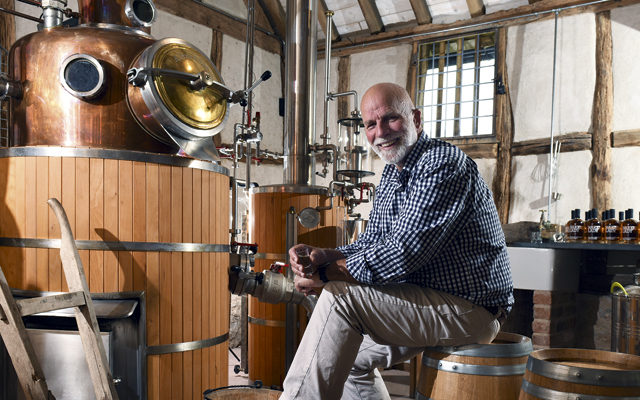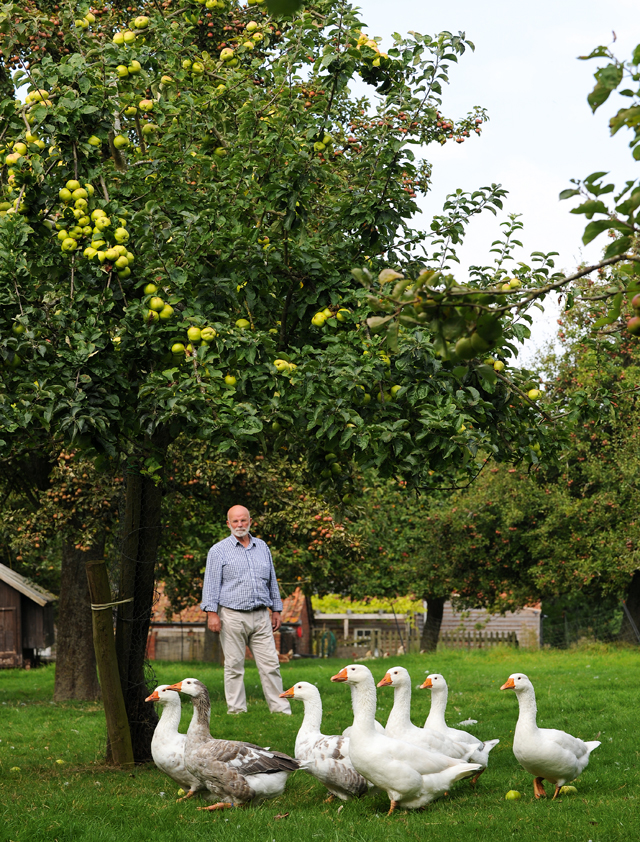Bring on the perry revival
Jane Wheatley heads for the Cotswolds, where the pear-based drink perry could be making a comeback.


As a young man in the 1970s, earning £30 a week driving lorries for an agricultural company, Charles Martell developed an obsession with perry pears. On his rounds to Gloucestershire farms, he observed the big, stately trees, up to 60ft tall, thick with blossom in early spring, laden with small hard fruit in summer, and began to record their names: Painted Lady and Brown Bess, Hendre Huffcap and Red Horse.
Certain varieties thrived only in one village or in a small area where the soil was right; some trees were falling down, most were neglected, their fruit left to rot on the ground. Mr Martell started taking cuttings with the owner’s permission and propagating them at home in the village of Dymock. Later, he would create the first national collection of perry pears at the Three Counties showground in Malvern.
These days, Mr Martell is a well-known cheesemaker and distiller of perry spirit, yet he says that, as a young man, he had no thoughts of a career: ‘I came to it for saving pears.’ His bestselling cheese is Stinking Bishop, named after a pear its bright orange rind is washed in perry juice. His single-variety spirit is made from Dymock Red. ‘It’s our local pear,’ he says proudly. ‘I thought it was extinct and hunted it for a long time it was one of the last I found.’
On a warm August morning, he takes me for a tour of his pear orchard. ‘This is Hedgehog,’ he says, patting the silvery-grey trunk of a fine tree, its small, round fruit nodding just above our heads. ‘When I planted it 37 years ago, it was the circumference of my thumb; now, it’s the same size as my stomach. We both get fatter each year.’

At its best, perry is a fine, amber liquor, delicate, floral and closer in taste to wine than cider. Indigenous to Gloucestershire, Herefordshire and Worcestershire, for centuries, perry was routinely made each year by most farmers and smallholders, with some being squirrelled away for home consumption and the rest sold to merchants. But by the time Mr Martell started his rescue mission, perry had fallen from favour as with decent bread, draught ale and artisan cheese, swept aside by the post-Second World War hunger for novelty, it would be 20 years before it enjoyed the glimmerings of a revival.
Orchards were being grubbed up in pursuit of subsidies and the only new plantings were in Somerset, where Showerings made the first alco-pop, a sparkling perry in a mini-Champagne bottle aimed at the female market. ‘Babycham was the first drink a woman could order [in a pub] without feeling like a tart or a crone,’ wrote author Philip Norman. The Somerset plantings failed and Showerings had to import pears. ‘Lorryloads would go from here,’ recalls Mr Martell. ‘A huge lorry would sit in the village overnight, leaking juice from the back, and old boys would come and collect buckets of it to make perry.’
At the nearby Orchard Centre in Hartpury, Jim Chapman is the curator of the new National Collection of perry pears 100 varieties, each with its own smart tree guard to protect it from grazing sheep. Perry pears take longer to mature than cider trees and many may not be cropping in his lifetime, but, as the saying goes, you grow pears for heirs.
Sign up for the Country Life Newsletter
Exquisite houses, the beauty of Nature, and how to get the most from your life, straight to your inbox.
A former solicitor and self-confessed perry nerd, Mr Chapman is working on the definitive history of the pear. ‘It should be going to the publisher about now, but I’m afraid a lot of it is still up here,’ he admits, patting his head.
Perry is England’s very own tipple: in its heyday in the 18th and early 19th centuries, it was popular in the bars of Parliament, in gentlemen’s clubs and in the drawing rooms of grand houses. An estate owner in the Three Counties would serve his best vintage to guests with pride and, according to Mr Chapman, today’s producers have yet to match the same standard. Millions of gallons of perry were sent down the River Severn to the Bristol docks and exported on sailing ships to outposts of the Empire, where the Crown’s loyal servants could sit back on their verandahs and enjoy a taste of home.
During the Napoleonic wars, sales of perry reached new heights as French wine languished in warehouses on the other side of the Channel. Imports of Champagne also halted and so, faute de mieux, people began making sparkling perry. Once the wine started flowing again, canny Bristol merchants would bulk it out with stocks of much cheaper home-produced stuff.
Happily, there has been a renewal of interest in perry cider company Westons has planted 10 acres of new pears and Peter Mitchell runs regular training courses for would-be producers at The Orchard Centre. He also makes perry under his own label, most of it sparkling. ‘Bottle-fermented perry is as good as a lot of Champagnes,’ he insists. ‘But consumers won’t pay anything like the same price.’
His students come from all over the world and, in America, the perry market is doubling in size every year. ‘They’ve imported stock from the UK,’ Mr Mitchell explains, ‘and Oregon State University has a germplasm of genetic material. There’s a lot of trial and error to match varieties with soil and climate terroir has a massive impact on perry.’
Dennis Gwatkin makes multi-award-winning, barrel-aged perry on his family farm in Herefordshire (http://gwatkincider.co.uk). ‘When I started 24 years ago, you could have counted the number of people making perry on the fingers of one hand,’ he remembers. ‘Now, there are about 50 in this county alone.’ It used to upset him that people knew all about French wines and German lagers, but had no idea what perry was. ‘Then, the big firms started to bring out pear cider and, awful as some of this stuff is made mostly from dessert pears it got people interested in perry pears.’
Perry is trickier than cider to make, he cautions. ‘It’s the fairer fruit, but there’s a lot that can go wrong. Perry needs to be made as soon as it falls: farmers used to go round their orchards, give the trees a little shake, pick up the fallers and go straight to the shed to put them through the press. No one’s got the time to do that now. One out of three years, you’ll lose the crop because the frost gets the blossom. And you have to watch it in the barrel as the yeast and the sediments settle at the botto they’re what gives it body, but if you leave it too long, it can turn nasty.’
Like cider, consumption of some perries can have strange effects and a warning is writ large in the old names Lumberskull, Merrylegs, Lightening, Bloody Bastard. Mr Gwatkin’s uncle grew 40 varieties at his farm on the River Severn. ‘I always remember,’ he grins, ‘there was this big old tree in the corner of his field, great big cropper it was, covered in pears, but he always said “Don’t have that one boy, them’s Circus pears”.
I never knew what he meant, but, years later, he explained the name: “Once round the ring and out”.’
For more information on tastings and classes at The Orchard Centre, visit www.tasteandexplore.com
This article was originally published in Country Life October 1, 2014
Country Life is unlike any other magazine: the only glossy weekly on the newsstand and the only magazine that has been guest-edited by HRH The King not once, but twice. It is a celebration of modern rural life and all its diverse joys and pleasures — that was first published in Queen Victoria's Diamond Jubilee year. Our eclectic mixture of witty and informative content — from the most up-to-date property news and commentary and a coveted glimpse inside some of the UK's best houses and gardens, to gardening, the arts and interior design, written by experts in their field — still cannot be found in print or online, anywhere else.
-
 Vertigo at Victoria Falls, a sunset surrounded by lions and swimming in the Nile: A journey from Cape Town to Cairo
Vertigo at Victoria Falls, a sunset surrounded by lions and swimming in the Nile: A journey from Cape Town to CairoWhy do we travel and who inspires us to do so? Chris Wallace went in search of answers on his own epic journey the length of Africa.
By Christopher Wallace
-
 A gorgeous Scottish cottage with contemporary interiors on the bonny banks of the River Tay
A gorgeous Scottish cottage with contemporary interiors on the bonny banks of the River TayCarnliath on the edge of Strathtay is a delightful family home set in sensational scenery.
By James Fisher